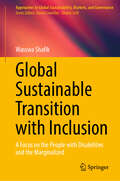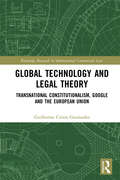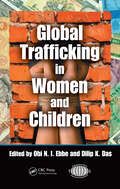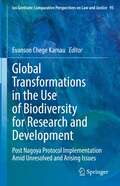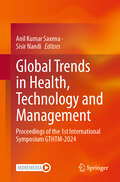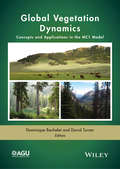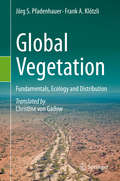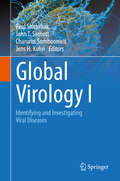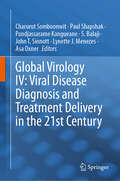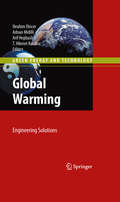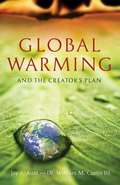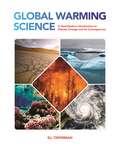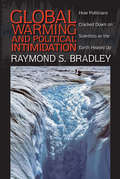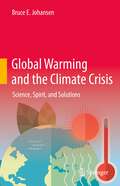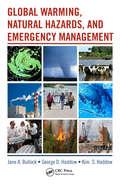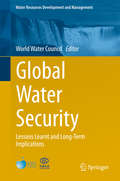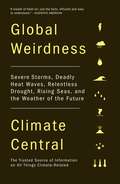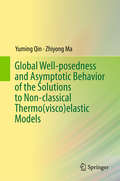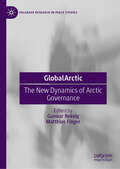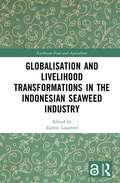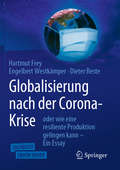- Table View
- List View
Global Sustainable Transition with Inclusion: A Focus on the People with Disabilities and the Marginalized (Approaches to Global Sustainability, Markets, and Governance)
by Wasswa ShafikThis book provides a comprehensive exploration of inclusive, sustainable development, emphasizing the critical need to integrate the perspectives and needs of people with disabilities and marginalized communities into the global sustainability transition to a sustainable future. Through highlighting the intersectionality of identity and the unique challenges faced by these groups, the book addresses a pressing issue: the often-overlooked barriers that hinder their full participation in sustainable transitions. Organized into three parts, the book first contextualizes the relationship between sustainability and inclusion. It delves into the historical and theoretical frameworks that shape our understanding of marginalization, exploring how disability intersects with various social identities. This foundation sets the stage for an in-depth analysis of the United Nations Sustainable Development Goals (SDGs) and the ways in which they can be made more inclusive, ensuring that no one is left behind. The second part identifies and examines the myriad barriers to inclusion within sustainable practices. It addresses structural, socioeconomic, and cultural obstacles that perpetuate exclusion while also critiquing existing policy frameworks for their limitations in addressing the needs of marginalized populations. Through case studies, the book highlights successful initiatives and innovative practices that promote accessibility and equity, mainly through the use of assistive technologies and community engagement. In the final section, the book outlines actionable strategies for fostering inclusive, sustainable development. It emphasizes the importance of community engagement, participatory decision-making, and the empowerment of marginalized voices. Additionally, it discusses metrics for monitoring and evaluating the impact of sustainability initiatives on people with disabilities, providing a framework for accountability and continuous improvement. This book aims to bridge the gap between sustainability and social justice, offering a roadmap for stakeholders, policymakers, and practitioners committed to creating a more inclusive world. This book targets academics, policymakers, non-profit societies, and activists working at the intersection of sustainability and social equity and serves as a vital resource for those seeking to understand and promote inclusive practices in the global sustainable transition.
Global Technology and Legal Theory: Transnational Constitutionalism, Google and the European Union (Routledge Research in International Commercial Law)
by Guilherme Cintra GuimarãesThe rise and spread of the Internet has accelerated the global flows of money, technology and information that are increasingly perceived as a challenge to the traditional regulatory powers of nation states and the effectiveness of their constitutions. The acceleration of these flows poses new legal and political problems to their regulation and control, as shown by recent conflicts between Google and the European Union (EU). <P><P> This book investigates the transnational constitutional dimension of recent conflicts between Google and the EU in the areas of competition, taxation and human rights. More than a simple case study, it explores how the new conflicts originating from the worldwide expansion of the Internet economy are being dealt with by the institutional mechanisms available at the European level. The analysis of these conflicts exposes the tensions and contradictions between, on the one hand, legal and political systems that are limited by territory, and, on the other hand, the inherently global functioning of the Internet. The EU’s promising initiatives to extend the protection of privacy in cyberspace set the stage for a broader dialogue on constitutional problems related to the enforcement of fundamental rights and the legitimate exercise of power that are common to different legal orders of world society. Nevertheless, the different ways of dealing with the competition and fiscal aspects of the conflicts with Google also indicate the same limits that are generally attributed to the very project of European integration, showing that the constitutionalization of the economy tends to outpace the constitutionalization of politics. <P><P> Providing a detailed account of the unfolding of these conflicts, and their wider consequences to the future of the Internet, this book will appeal to scholars working in EU law, international law and constitutional law, as well as those in the fields of political science and sociology.
Global Trafficking in Women and Children (International Police Executive Symposium Co-Publications)
by Dilip K. Das Obi N. I. EbbeWar, poverty, and famine; political, social, and economic change; and the deep seated views and rituals rooted in a culture‘s history and traditions all contribute to the widespread and growing trafficking of women and children. The multilayered complexity, myriad contributing factors, enormous amount of money involved, and sheer magnitude of the
Global Transformations in the Use of Biodiversity for Research and Development: Post Nagoya Protocol Implementation Amid Unresolved and Arising Issues (Ius Gentium: Comparative Perspectives on Law and Justice #95)
by Evanson Chege KamauEnough laws have been enacted since the adoption of the Nagoya Protocol on access and benefit-sharing to permit a study which is capable of accurately portraying the status quo of national implementation of the Protocol and the ensuing practice, emerging challenges and how countries are coping with them. This book, one of the first to present such a study, uniquely combines an examination of the new laws and practice and how they comply with the Nagoya Protocol; of issues not yet resolved by the Protocol and which solutions are being explored; and of how research and development is responding to the new situation. In addition, it proposes solutions to selected questions on ABS based on real-world and hypothetical cases, which could instigate litigation.Written by a team of expert academics and practitioners in the field, this book makes a valuable contribution to academic and policy debates and to academic literature on international environmental law, international biodiversity law, international property law, climate law and the law of indigenous populations. It also offers a reference guide for practicing lawyers in the area of ABS.
Global Trends in Health, Technology and Management: Proceedings of the 1st International Symposium GTHTM-2024
by Anil Kumar Saxena Sisir NandiThis book presents the proceedings of the 1st International Symposium on Global Trends in Health, Technology and Management (GTHTM-2024), held on March 15-17, 2024, in Dehradun, India. It reports on recent advances in the interdisciplinary fields of health, technology, and management covering a broad spectrum of topics like drug discovery and development including diseases like cancer, tropical and lifestyle diseases, agroecology, artificial intelligence, and machine learning. The symposium is jointly organised by the Global Health Techno Management Forum and the Global Institute of Pharmaceutical Education and Research, Kashipur, India, together with the Veer Madho Singh Bhandari Uttarakhand Technical University, Dehradun, India. It builds on the success of previous conferences such as the International Symposium on Drug Design and Development Research (DDDR-2021), International Symposium on Current Trends in Pharmaceutical and Medical Sciences (CTPMS-2020), International seminar on Global Trends in Health and Environment (2016), International Seminar on Pharmaceutical Education and Research (ISPER-2010), and the 9th International Symposium on Computational Methods in Toxicology and Pharmacology Integrating Internet Resources (CMTPI-2017). Offering a timely snapshot of cutting-edge, multidisciplinary research and developments in drug design and health sciences, these proceedings facilitate the transfer of these findings to industry and offer a unique perspective on One Health sustainability. As such, the book will appeal not only to students and researchers but also to professionals interested in these fields.
Global Vegetation Dynamics: Concepts and Applications in the MC1 Model
by David Turner Dominique BacheletGlobal Vegetation Dynamics: Concepts and Applications in MC1 model describes the creation in the mid 1990s, architecture, uses, and limitations of the MC1 dynamic global vegetation model (DGVM) that is being used by an increasing number of research groups around the world. The scientific foundation of most models is often poorly documented and difficult to access, and a centralized source of information for MC1, including the complete list of over eighty papers and reports with MC1 results will be useful to scientists and users who want to better understand the model and the output it generates. Global Vegetation Dynamics: Concepts and Applications in MC1 model will be a valuable resource for students and researchers in the fields of climate change science, conservation science, biogeochemistry and ecology, as well as for land managers looking for a better understanding of the projections of climate change impacts and of the tools that have been developed to produce them.he fire model, which was the first of its kind among dynamic global vegetation models; a brief history of the model creation; summaries of model results at the continental (North America), regional (Pacific Northwest), and local (Wind Cave NP and Sierra Nevada) scales; a description of its use to transform a state and transition model into its climate-smart version to help managers prepare for climate change challenges; and the description of an on-line tool (databasin.org) that provides snapshots as well as animated time series of its results. Finally, a complete bibliography (as of spring 2015) lists over 80 publications that include MC1 results. Global Vegetation Dynamics: Concepts and Applications in the MC1 model will be a valuable resource for students and researchers in the fields of climate change science, conservation science, and biogeochemistry and ecology, as well as for land managers looking for a better understanding of the projections of climate change impacts and of the tools that have been developed to produce them.
Global Vegetation: Fundamentals, Ecology and Distribution
by Jörg S. Pfadenhauer Frank A. KlötzliThis up-to-date textbook of global vegetation ecology, which comprises the current state of knowledge, is long overdue and much-needed. It is a translation of the textbook “Vegetation der Erde” (Springer-Spektrum, Heidelberg). A short introductory chapter deals with the fundamentals of vegetation ecology that are of importance for the delimitation and characterization of the global vegetation presented in this book (chorology, evolution of plants, physiognomic and structural characteristics, phytodiversity and the human impact on it as well as general terminology concerning both plant growth forms and on vegetation structure types). In the following chapters the zonal and azonal vegetation from the tropics to the polar regions including high mountains is described and discussed. The main focus is on the characterization of interactions between the spatial location of plants and plant communities on the one hand and site conditions, historic and genetic processes, spatial and temporal patterns, ecophysiology and anthropogenic influences on the other hand. Additional information on specific topics is provided in 51 boxes.
Global Virology I - Identifying and Investigating Viral Diseases
by Jens H. Kuhn Paul Shapshak John T. Sinnott Charurut SomboonwitThis book provides trajectories and illustrations of viruses that have catapulted into the global arena (linked to humans, animals, and vectors) due to human behaviors in recent years, as well as viruses that have already shown expansion among humans, animals, and vectors just a few decades ago. Topics in the current book include: vaccines environmental impact emerging virus transmission Filovirus (Ebola) hemorrhagic fevers flaviviruses Dengue evasion papillomaviruses Hepatitis C Nipah virus giant viruses hantaviruses bunyaviruses encephalitides West Nile virus Zika virus XMRV henipaviruses human respiratory syncytial virus influenza A virus several aspects of HIV-1
Global Virology IV: Viral Disease Diagnosis and Treatment Delivery in the 21st Century
by Pandjassarame Kangueane Paul Shapshak John T. Sinnott Charurut Somboonwit S. Balaji Lynette J. Menezes Asa OxnerIn the face of recent viral outbreaks and a global viral pandemic, the necessity for innovation and continued rapid advancement in viral diagnosis and treatment methods has become even more apparent. Global Virology IV: Viral Disease Diagnosis and Treatment Delivery in the 21st Century explores the latest advances in virology and trends in clinical practice, focused on foundational principles and advancements expected to significantly impact this field. Chapters address SARS-CoV-2, Ebola, Zika, Mpox, and Hepatitis C, among other key viral threats, before presenting a detailed analysis of antiviral agents broadly and concerning specific vulnerable populations such as stem cell and solid organ transplant recipients. It is designed as a helpful resource for medical students, scientists, and professionals, bridging current practice and future applications and inspiring further innovations and improvements in global health.
Global Warming
by Ibrahim Dincer Adnan Midilli T. Hikmet Karakoc Arif HepbasliGlobal Warming: Engineering Solutions goes beyond the discussion of what global warming is, and offers complete concrete solutions that can be used to help prevent global warming. Innovative engineering solutions are needed to reduce the effects of global warming. Discussed here are proposed engineering solutions for reducing global warming resulting from carbon dioxide pollution, poor energy and environment policies and emission pollution. Solutions discussed include but are not limited to: energy conversion technologies and their advantages, energy management and conservation, energy saving and energy security, renewable and sustainable energy technologies, emission reduction, sustainable development; pollution control and measures, policy development, global energy stability and sustainability.
Global Warming
by Dr William M. Curtis III Jay A. AuxtDroughts, floods, hurricanes, cyclones. We constantly hear of extreme weather conditions all over the world. We hear dire warnings like "Flee hurricane Ike, or face certain death, officials warn." To be politically correct, we must assume that these are a direct result of global warming. However, is this true? - Jay Auxt, Global Warming and the Creator?s Plan. God has a clear plan for this earth and its inhabitants. Although the media would have you believe the earth is doomed due to global warming, the truth is that the earth has always been warming very gradually and that the current warming is insignificant - especially considering the scope of God's ultimate plan for each and every one of us. Unlock the clues to this contemporary controversy by discovering: Old Testament biblical references from the past Scientific data of the present Biblical prophecy for the future Contrary to secular media, this book clearly illustrates that the concept of "man induced global warming" is totally unfounded, and that God alone is in control of our destiny. Learn to sift unsupported rumor and alarmist rhetoric from verifiable facts on this hot-button issue with Global Warming and the Creator's Plan. This was a very revealing book and it sure gave me something to think about. I realize the media has its own agenda, but this book helps us to remember that God has a plan and ultimately it is His plan that will prevail. The book was very well-researched and easy to read as well. I recommend it. -- Dave H. from Book Bargains and Reviews
Global Warming
by Saddleback Educational Publishing StaffThemes: Hi-Lo, nonfiction, full-color, differentiated instruction. Teach environmental studies and global warming in the inclusive classroom with these unique informational books. Available in two reading levels with identical front covers, so striving readers do not feel "singled out," each title methodically explains the tough problems faced by our planet plus solutions large and small. Features include: Reading level 3 books are Fountas-Pinnell level O, P, and Q; reading level 6 books are Fountas-Pinnell level W. Scientific terms are defined in context. Identical dramatic four-color covers (back cover band identifies books that are lower level). Teacher's Guides with reproducible activities allow students to work from either text. Glossary defines difficult terms. "Did You Know?" sections contain interesting facts. End-of-book "Facts & Figures" section summarizes critical information. The index takes students directly to topics of interest.
Global Warming
by Susan PhilipOur earth is getting hotter and hotter. As a result, the polar ice caps are melting, the water levels in the oceans are rising, soon low-lying, small islands will vanish, there will be less and less rainfall so crops will die, and we humans will face shortage of food and drinking water. Animals and birds will soon start disappearing. If you thought this was the script of some new sci-fi movie, you are mistaken. All this is already happening as a result of Global Warming-the new threat Planet Earth is facing. This book is all about this scary natural phenomenon which is worrying scientists and countries around the world.
Global Warming Science: A Quantitative Introduction to Climate Change and Its Consequences
by Eli TzipermanA quantitative, broad, hands-on introduction to the cutting-edge science of global warmingThis textbook introduces undergraduates to the concepts and methods of global warming science, covering topics that they encounter in the news, ranging from the greenhouse effect and warming to ocean acidification, hurricanes, extreme precipitation, droughts, heat waves, forest fires, the cryosphere, and more. This book explains each of the issues based on basic statistical analysis, simple ordinary differential equations, or elementary chemical reactions. Each chapter explains the mechanisms behind an observed or anticipated change in the climate system and demonstrates the tools used to understand and predict them. Proven in the classroom, Global Warming Science also includes “workshops” with every chapter, each based on a Jupyter Python notebook and an accompanying small data set, with supplementary online materials and slides for instructors. The workshop can be used as an interactive learning element in class and as a homework assignment.Provides a clear, broad, quantitative yet accessible approach to the science of global warmingEngages students in the analysis of climate data and models, examining predictions, and dealing with uncertaintyFeatures workshops with each chapter that enhance learning through hands-on engagementComes with supplementary online slides, code, and data filesRequires only elementary undergraduate-level calculus and basic statistics; no prior coursework in science is assumedSolutions manual available (only to instructors)
Global Warming and Political Intimidation: How Politicians Cracked Down on Scientists as the Earth Heated Up
by Raymond S. BradleyGlobal warming is the number one environmental issue of our time, yet some prominent politicians have refused to accept scientific evidence of human responsibility and have opposed any legislation or international agreement that would limit greenhouse gas emissions. A few have gone even further and have tried to destroy the reputations of scientists researching climate change by deliberately undermining the credibility of their research. These politicians have sought to sow seeds of doubt in the minds of the public and to weaken public and political support for the control of fossil fuel use. one scientist who was unwittingly ensnared in a web of political intimidation. In this powerful book, highly respected climate scientist Raymond Bradley provides the inside story from the front lines of the debate. In clear and direct language, he describes the tactics those in power have used to intimidate him and his colleagues part of a larger pattern of governmental suppression of scientific information, politics at the expense of empirically based discourse. Speaking from his experience, Bradley exposes the fault lines in the global warming debate, while providing a concise primer on climate change. The result is a cautionary tale of how politics and science can become fatally intertwined.
Global Warming and the Climate Crisis: Science, Spirit, and Solutions
by Bruce E. JohansenThis textbook introduces readers to basic scientific principles of climate change. Based on extensive empirical evidence, it explains weather events that indicate climate change’s evolution and presents important topics connected to climate change, such as political controversies, climate policy, as well as Native American perspectives. Finally, it presents attempted solutions, including policy recommendations and technological proposals for necessary changes in our world.Providing a well-written and easy-to-follow overview of knowledge of science-based geophysical facts, including thermodynamics, the book puts a strong emphasis on why expeditious action on global warming is urgent. The book also explains why smart greenhouse-gas reduction strategies will ignite economic growth, generate new domestic jobs, protect public health, and strengthen energy security.Not assuming a scientific background on the part of the reader, Global Warming and the Climate Crisis: Science, Spirit, and Solutions offers an ideal supplemental reading in many types of courses in Earth sciences, climate policy, climate change sciences, as well as politics of climate change, from high school through undergraduate. General readers also will benefit from its treatment of this very important and timely issue.
Global Warming, Natural Hazards, and Emergency Management
by Jane A. Bullock George D. Haddow Kim S. HaddowScientists predict the earth is facing 40-to-60 years of climate change, even if emissions of carbon dioxide and other global warming gases stopped today. One inevitable consequence of the greenhouse gases already in the atmosphere will be an increase in the frequency and severity of natural disaster events. Global Warming, Natural Hazards, and Eme
Global Water Security
by World Water CouncilThis book highlights the relationship between the water sector and various other sectors in order to establish an improved understanding of the importance of water resources as an essential cross-cutting vector of socio-economic development. The book is both policy and practice oriented and is not constrained by existing definitions on water security. It includes actual experiences of policy, management, development and governance decisions taken within the water sector, and examples on how these have affected the energy and agricultural sectors as well as impacted the environment, and vice versa, as appropriate. It also discusses trade-offs, short and long-term implications, lessons learnt, and the way forward. The book includes case studies on cities, countries and regions such as Australia, China, Singapore, Central Asia, Morocco, Southern Africa, France, Latin America, Brazil and California.
Global Weirdness: Severe Storms, Deadly Heat Waves, Relentless Drought, Rising Seas and the Weather of the Future
by Climate CentralProduced by Climate Central—a highly regarded independent, nonprofit journalism and research foundation founded in 2008—and reviewed by scientists at major educational and research institutions the world over, Global Weirdness summarizes, in clear and accessible prose, everything we know about the science of climate change; explains what is likely to happen to the climate in the future; and lays out in practical terms what we can and cannot do to avoid further shifts.<P> Sixty easy-to-read entries tackle such questions as: Is climate ever “normal”? Why and how do fossil-fuel burning and other human practices produce greenhouse gases? What natural forces have caused climate change in the past? What risks does climate change pose for human health? What accounts for the diminishment of mountain glaciers and small ice caps around the world since 1850? What are the economic costs and benefits of reducing carbon emissions?<P> Global Weirdness enlarges our understanding of how climate change affects our daily lives, and arms us with the incontrovertible facts we need to make informed decisions about the future of the planet and of humankind.
Global Well-posedness and Asymptotic Behavior of the Solutions to Non-classical Thermo(visco)elastic Models
by Yuming Qin Zhiyong MaThis book presents recent results on some global existence, uniqueness and large-time behavior of global solutions of thermo(vis)coelastic systems and related models arising from physics, mechanics and material science such as thermoviscoelastic systems, thermoelastic systems of types II, III and with second sound, Timoshenko-type system with past history. Part of the book is based on the research carried out by the authors and their collaborators in recent years. The book will benefit both the interested beginner in the field and the expert.
GlobalArctic: The New Dynamics of Arctic Governance (Palgrave Research in Peace Studies)
by Matthias Finger Gunnar RekvigThe third volume in the Global Arctic series examines the transformation of Arctic governance following the 2022 outbreak of war in Ukraine. This conflict has disrupted the post-Cold War cooperative circumpolar order, upending decades of multilateral collaborations. The book traces the Arctic's evolution from Cold War great power competition to a focus on human security and cooperation, highlighting the Arctic Council's establishment and the growth of the "Arctic family" with non-Arctic actors. It explores how climate change became a key driver for Arctic (re)engagement, opening new opportunities and challenges. The 2022 invasion of Ukraine has dramatically altered this landscape, ending the post-Cold War era of collaboration and ushering in the post-post-Cold War era, raising critical questions about regional cooperation, climate change mitigation, and global security. This book brings together diverse expert perspectives to analyze the rapidly changing geopolitical dynamics of the Arctic. It explores the tension between collaboration needs and resurgent great power competition, offering valuable insights for policymakers, scholars, and students. As global power dynamics shift and climate change threatens, understanding Arctic governance challenges becomes imperative. This book serves as an essential resource for navigating the complex Arctic political landscape and examining how new divisions are reshaping the region's future.
Globale nukleare Entwicklungen: Einblicke eines ehemaligen IAEO- Nuklearwaffeninspektors
by Pantelis F. IkonomouDieses Buch wurde von einem ehemaligen Nuklearinspektor der Internationalen Atomenergiebehörde (IAEO) und Experten für nukleare Sicherheit geschrieben und bietet einen umfassenden und authentischen Überblick über die aktuellen globalen Entwicklungen im Nuklearbereich. Der Autor gibt detaillierte Einblicke in aktuelle und vergangene Nuklearkrisen und legt die technischen Fähigkeiten, politischen Strategien und Motive der Besitzer von Atomwaffen offen. Durch die Analyse der Nuklearprogramme und -strategien verschiedener Länder, darunter die USA, Russland, China, Großbritannien und Frankreich, verdeutlicht dieses Buch die bestehende globale nukleare Bedrohung und die damit verbundenen Risiken für die Menschheit. Es beschreibt auch die derzeitigen Blockaden und zeigt mögliche Auswege auf. Aufgrund seines Umfangs wird das Buch Wissenschaftler und politische Entscheidungsträger ansprechen, die daran interessiert sind, neue Einblicke in sensible oder komplexe Nuklearprogramme verschiedener Länder zu gewinnen.
Globalisation and Agricultural Landscapes: Change Patterns and Policy Trends in Developed Countries
by Jørgen Primdahl Simon SwaffieldWhilst agricultural landscapes are products of the local ecosystem and community in which they are situated, they are becoming increasingly affected by the same global issues, and are converging under the dynamics of globalisation. Combining landscape ecological research and an examination of relevant public policy, this book investigates the dynamic relationship between agricultural landscapes and the global change processes, such as urbanisation, by which they are being transformed. Landscape change is analysed in the context of biophysical patterns, market dynamics, and specific public policy frameworks, through a series of case studies from different OECD countries spanning Europe, Asia Pacific and North America. Particular emphasis is placed upon the way that landscapes are changing under differing policies of agricultural subsidy including the EU Common Agricultural Policy. This is an ideal resource for graduate students and researchers in landscape ecology and agriculture as well as policy analysts working in the agricultural sector.
Globalisation and Livelihood Transformations in the Indonesian Seaweed Industry (Earthscan Food and Agriculture)
by Zannie LangfordThis book explores the rapidly changing seaweed industry in Indonesia, the largest global producer of carrageenan-bearing seaweeds. Seaweed production in Indonesia has grown exponentially over the last twenty years, and rural communities across the country have embraced this new livelihood activity. This book begins with an examination of the global carrageenan seaweed industry, from the global market for carrageenan in processed foods, to the national and regional contexts in Indonesia across which it is farmed, processed, and traded. It then explores the ways that rural communities have reshaped their lives around seaweed production, with chapters on agrarian transformations, negotiations over access to sea space, farmer decision-making in presence of environmental, social and economic constraints, the role of women and casual labourers in the industry, and the marketing of seaweed through social networks. Based on a multi-disciplinary research initiative, this book demonstrates the interrelatedness of environmental, social and economic dynamics on seaweed production, processing and trade, and argues for key policy interventions to support the sustainable development of the industry in the context of climate change. It also provides a lens for understanding and improving the broader processes of sustainable rural development in a rapidly globalising and commercialising world. This book will be of great interest to students and scholars of aquaculture, food systems, agricultural economics, rural studies and sustainable development.
Globalisierung nach der Corona-Krise: oder wie eine resiliente Produktion gelingen kann – Ein Essay
by Engelbert Westkämper Dieter Beste Hartmut FreyUnterbrochene Lieferketten, Schwierigkeiten im Nachschub einfachster medizinischer Schutzkleidung (z. B. Mundschutz) im Rahmen der Corona-Krise bieten Anlass die Globalisierung zu hinterfragen. Den gegenwärtigen Spielregeln der Globalisierung sind die Perspektiven einer digitalisierten Wirtschaftsordnung mit entsprechenden Geschäftsmodellen für die Zukunft gegenübergestellt. Es ist dargelegt, welche Prozesse und Verfahren diese Entwicklung unterstützen und es ist ein Ausblick gegeben, wie sich diese Entwicklung auch auf bildungs- und forschungspolitische Aspekte auswirken kann.
